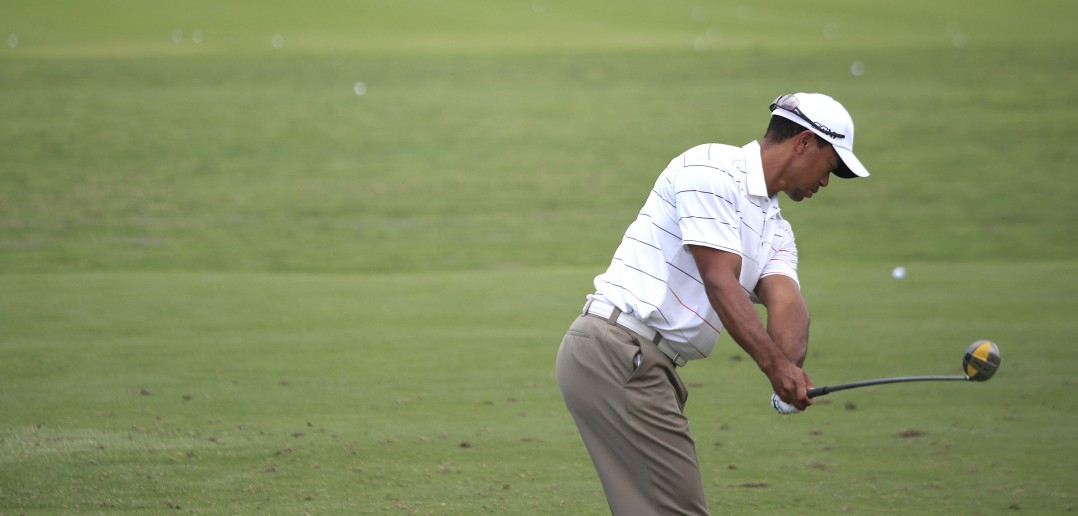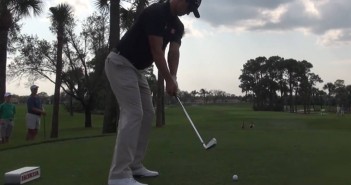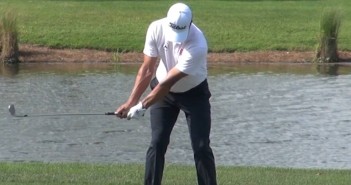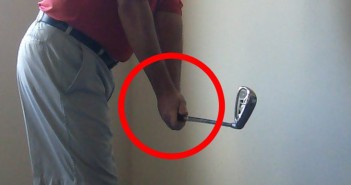Most golfers misunderstand the purpose of the takeaway, and greatly underestimate its importance.
It’s well known that the takeaway, as part of the backswing, helps you to generate power through the turning of your body, and that a good takeaway helps towards good rhythm and tempo in your swing.
But the perfect takeaway also plays a crucial role in establishing not only the initial path of the golf club as it moves away from the ball, but the path through the whole of your golf swing, and it has a significant effect on your swing’s power, consistency and accuracy.
The perfect takeaway puts you in a position to swing in balance, it establishes the width of your swing arc, and it enables you to consistently arrive at the top of your backswing with your body in the correct position, and moving in the correct sequence, so that you can make a great downswing.
The downswing happens way to quickly for you to consistently and efficiently compensate for being even slightly out of synch coming into the transition at the top of your swing.
And, perhaps most importantly from your perspective as someone trying to improve your swing, a perfect takeaway dramatically reduces the time and effort required to learn a great golf swing. It simplifies the whole swing, removes the need for complex compensations and manipulations later in the swing, and thus promotes repetition and consistency.
Many very good golfers have had less than perfect takeaways over the years, but the time and effort that it took them to reach such a high standard would have been dramatically reduced if they had learned a simpler, more efficient, takeaway at an early stage of their development. Maintaining your swing, increasing your skill levels, learning new shots, fixing faults, increasing efficiency and power — it all becomes a lot easier once the basics are in place.
A great takeaway won’t guarantee a great golf swing, but it has a significant positive influence when done properly, and a poor takeaway makes a consistently good golf swing incredibly difficult.
What is the Golf Swing Takeaway?
For the purposes of the Swing like a Champion system, the takeaway is defined as the sequence of movements from the first move away from the address position, through to the point where the golf club shaft is parallel with the ground. From that point you move into the backswing, which is described in the next section.
Note, however, that apart from your address position, there are no static positions in the golf swing, only positions that you move through. This is an important distinction to understand. While we will use descriptions of positions to help you learn and to check your progress, such positions are not, in themselves, a fundamental part of the golf swing. Two golfers could have exactly the same “end of the takeaway” position or “top of the backswing” position, but one could be an elite golfer and the other a high handicapper. Positions are useful, up to a point, but the quality of your golf swing lies in how your body is moving through that point in time, the sequence and precise timing of your movements. Good positions are only a symptom of moving your body correctly.
Thus, the takeaway isn’t simply a matter of moving from position A to position B. It is a sequence of body movements, of specifically timed muscle activations and shifts in your balance. The position of the golf club, which we use to define the takeaway, is important, but it’s only a consequence of how you move your body. You could move the club to the same position using different movements of your body, and the quality of your golf swing would be severely compromised.
The perfect takeaway isn’t even a single or distinct move, it’s a sequence of movements that forms the start of the golf swing kinetic chain. That chain, or kinematic sequence, is anchored to the correct starting position by your perfect setup, and the takeaway forms the first few links in the chain that will lead to a great golf shot.
What Makes a Perfect Takeaway?
The perfect takeaway has a number of key characteristics:
- It creates the conditions necessary for a great golf swing, simplifying the whole swing by putting your body and the golf club in motion correctly from the beginning.
- While it’s perceived as “one piece” (though not in the way that this is often taught) as your arms and shoulders move in unison, it crucially separates the movement of different segments of your core, initiating a sequence that will build a powerful body coil in your backswing — the X-factor.
- It sets the golf club moving on the correct path. At this point, when the club is moving slowly, it is a weight on the end of a long stick. That weight has a lot of momentum, of leverage, and if it starts to move even slightly in the wrong direction then it will need a significant compensation to pull it back on track later in the golf swing. Such manipulations result in loss of power as energy transfer is disrupted, and they make timing the swing very difficult. The corrections themselves generate further unwanted momentum in the club head, and the golf swing quickly becomes far too complicated to ever be consistent.
- It shifts your weight away from the target, without significantly shifting your body or sliding your hips. This weight shift is crucial for generating power (try throwing a ball without shifting your weight), and by shifting it early we simplify the swing and enable a stable and consistent backswing.
- It generates width in the golf swing. The concept of width isn’t well understood by most golfers – it is not about having a wide downswing arc. You may think that a wide arc equals more club head speed, since the club head is travelling further, but in fact we require a wide backswing and a narrow downswing, utilising the compound pendulum effect in the downswing in order to generate enormous club head speed through impact. A wide downswing arc results in “casting” the club, and thus a significant loss of power. A wide takeaway and backswing is necessary for getting you and the golf club into a powerful position and sequence at the top of the backswing, into the transition.
- It establishes the correct relationship between your body segments, your arms, hands and the golf club, putting you in the perfect position to continue moving, simply and fluidly, into the perfect backswing.
The exact positions that you and the golf club should move through will be discussed shortly, once you’ve begun to learn how to move your body correctly for the perfect takeaway.
We begin to build your perfect takeaway using some simple drills. These drills will teach you how to move your body, how to use your muscles and how to sense what the perfect takeaway feels like.
Work your way through the drills carefully and patiently, one step at a time. Rushing ahead will only slow your skill development down. Remember that learning is a biological process, you’re “growing” your skill levels by creating and reinforcing the correct neural pathways in your brain. Each drill is carefully designed to build upon the last, so that the movements are ingrained as quickly as possible, in an accelerated learning process. Taking the time to ingrain these movements correctly will enable you to build on them, and to learn the whole swing more quickly. Once learned properly, these skills will stand up to pressure out on the golf course, and they will form a the foundation for a great golf swing that will last you a lifetime. For more information on how this process works, see How to Learn a Great Golf Swing.
If you have any questions or comments about this or other articles on Golf Loopy, please send us an email.
Let’s get started with learning how to move your body, with Golf Swing Drill 202 – Pelvic Disassociation.




